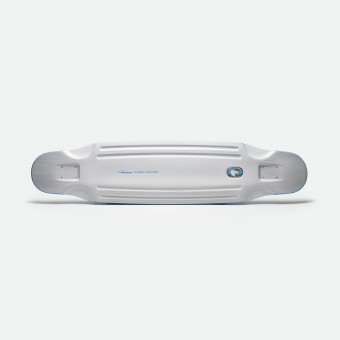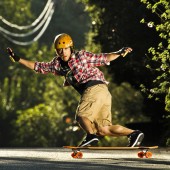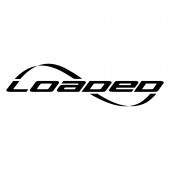Chubby Unicorn Freeride/Downhill Skateboard by Danny Carper |
Home > Winners > #27596 |
 |
|
||||
| DESIGN DETAILS | |||||
| DESIGN NAME: Chubby Unicorn PRIMARY FUNCTION: Freeride/Downhill Skateboard INSPIRATION: The Chubby Unicorn is a breakthrough board for Loaded, eight years in the making. The Chubby is the perfect example of form meeting function, striking an equal balance between technology, craftsmanship, innovation and overall rideability. As skateboard riding styles evolve so must the tools. The Chubby is Loaded’s answer for the downhill/freeride/fr UNIQUE PROPERTIES / PROJECT DESCRIPTION: The Chubby is strikingly different than anything seen to date. The ultralight basswood core has a continuous perimeter of baby blue Orangatang Urethane and is sandwiched between fiberglass/epoxy skins. Complex contours and custom grip tape are both functional and beautiful, creating a topography with rises and pockets to keep the riders’ feet in place. Flip the board over and this landscape is detailed on the two tone white UHMW bottom sheet. The millwork adds strength, weight savings and supercar-like lines. All of these elements come together flawlessly and make this board look more like a space shuttle than a skateboard. Without trucks and wheels this could easily be the hover board we are all waiting for. OPERATION / FLOW / INTERACTION: - PROJECT DURATION AND LOCATION: The project began in 2004 and finished in December 2012. |
PRODUCTION / REALIZATION TECHNOLOGY: The Chubby’s basswood core balances rigidity for speed with just enough give to dissipate energy from vibrations and impacts. Around the board’s perimeter is a high durometer Orangatang urethane sidewall. Bonded to the wood and fiberglass skins, the sidewall provides vibration damping throughout the entire board. The urethane formula has been carefully selected for exceptional abrasion resistance, crisp pop, and resilience against hard impact. The Chubby’s base is also sealed with a layer of UHMW for additional damping, abrasion resistance, and protection against moisture. SPECIFICATIONS / TECHNICAL PROPERTIES: Length: 42.25” Width: 9.75” – We designed this board with a men’s size 8 to 11 shoe in mind. This allows your toes and heels to slightly touch each rail for optimal board awareness and minimizes the need to shift your feet when transitioning from heelside to toeside slides. Although the width is slightly less than many other downhill boards on the market, we have tested with several foot sizes and have found it to be a comfortable size for most non-silverback riders. Additionally, the tapering near the nose provides much better ergonomics and rail control for a forward facing downhill tuck (where the rider’s front foot is often at a 45° or higher angle on the deck), whereas even large feet can get “lost” on a wider platform when in this position. Wheelbase: 28.25”– After spending years riding a variety of downhill boards with wheelbases ranging from 24” to 32”, we found ourselves consistently drawn toward the 27-29” range for its very natural shoulder width stance. With your feet in the pockets (see “Integrated Wheel Wells/Flares” below), your knees are kept in a slightly bent, athletic stance that promotes control and stability when throwing long, fast slides to manage your speed down steep descents. Short enough for good traction, cornering agility, and snappy drifts, yet long enough to provide high speed stability, a solid platform for control in fast slides, graceful rotations, and an appreciable amount of lean angle (even on 50° trucks). Kick length: 7” (tip to inner bolt) Weight: 4.9 lbs TAGS: Loaded Boards, Skate Board, Transportation, Composite, Sport, Leisure, Topological Surface, Action Sports, X Games RESEARCH ABSTRACT: The composite layup of the Chubby consists of a layer of triaxial E-glass followed by a pre-milled basswood core bound by a sidewall of Orangatang urethane followed by an additional layer of triaxial E-glass and finished off with a layer of UHMW. Our design team sought a composite construction primarily for its strength-to-weight ratio in comparison to a standard ply layup. However, reducing the weight of the deck produced a less damp feel when riding due to the lighter weight. To supplant the less damp feel we started exploring the integration of a urethane sidewall (derived from snowboard construction) which provided enhanced vibration damping as well as exceptional durability to side impact and abrasive wear. The urethane sidewall became an exploration in cross-pollinating material technologies acquired from Orangatang wheel development into Loaded deck construction. While we felt we were at a point where each material of the composite construction was dialed to a specific performance expectation, our team had to optimize the board for production. In order to do so, it took many iterations of precisely aligning composite layup with the complex compression molds. Additionally, we had to explore means of analyzing the pressed blank to account for springback (the process by which the severity of a deck’s curvatures are reduced after the part is removed from the mold). We started with a traditional method of cutting the board along known axes and charting the displacement between design sketches and the produced part, but due to the Chubby’s compound curvatures we were not initially able to get an accurate account of springback. Thus, we invested our research into a laser scanning device called the David scanner. This system allows us to set up calibration panels behind the object to be scanned and, using a laser, identify points along its surface to rebuild the physical surface into an accurate digital mesh. We concluded with a comprehensive process that accurately transmitted information, materially and geometrically, between the physical and digital realms. CHALLENGE: Our conceptual ambitions were set high for the Chubby, which produced a number of unforeseen process challenges. Consequently, we had to expand our in-house capabilities to nurture the beast into production. We explored a number of software applications to address the tectonic challenges of the deck’s construction. Given the complex contouring, we had to resolve a number of issues from 3D unrolling to pre-machined cores to complex tooling alignment to mythical hatching. The primary challenge our design team faced emerged from our desire to pre-mill a flat core to account for the features designed into the 3-dimensional finished deck. The closest parallel that comes to mind is the unrolled maps of the world; due to the spherical curvature of the earth, distortion must occur to the surface area of land masses and bodies of water when viewed in a 2D format. The same holds true with the Chubby. We developed a program that would cast a field of points onto the 3D deck and then rebuild a flattened mesh based on the x-, y-, and z-coordinates of each point. Ultimately, the resulting mesh was not accurate enough when we pressed a set of test boards. We then shifted our approach to a process used by video game developers in which they take a 2D scanned image of a face and map it onto a digital 3-dimensional form of a head. We mapped the Chubby’s 3D compound surface to a flat core surface and the results brought tears of joy. ADDED DATE: 2013-02-07 09:23:50 TEAM MEMBERS (5) : Loaded Boards, Orangatang Wheels, Capital L Manufacturing, Labeda and Robbie Lee IMAGE CREDITS: Danny Carper, 2012. |
||||
| Visit the following page to learn more: http://www.loadedboards.com/boards/chubb |
|||||
| AWARD DETAILS | |
 |
Chubby Unicorn Freeride/Downhill Skateboard by Danny Carper is Winner in Sporting Goods, Fitness and Recreation Equipment Design Category, 2012 - 2013.· Read the interview with designer Danny Carper for design Chubby Unicorn here.· Press Members: Login or Register to request an exclusive interview with Danny Carper. · Click here to register inorder to view the profile and other works by Danny Carper. |
| SOCIAL |
| + Add to Likes / Favorites | Send to My Email | Comment | Testimonials | View Press-Release | Press Kit |
Did you like Danny Carper's Sporting Goods Design?
You will most likely enjoy other award winning sporting goods design as well.
Click here to view more Award Winning Sporting Goods Design.








